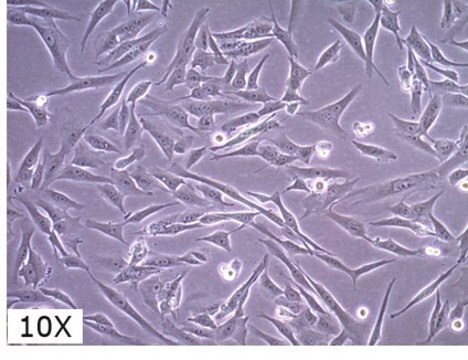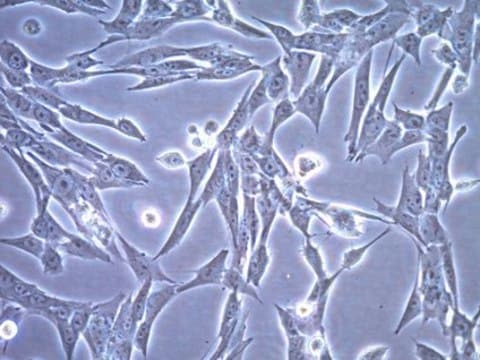SCC282
SF188 Human Glioblastoma Cell Line
SF188 human glioblastoma cell line is an important cellular model for pediatric human glioblastoma.
Synonim(y):
SF-188 cells
Zaloguj sięWyświetlanie cen organizacyjnych i kontraktowych
About This Item
Kod UNSPSC:
41106514
NACRES:
NA.81
Polecane produkty
Zastosowanie
cell analysis
Opis ogólny
Glioblastoma multiforme is the most common and malignant primary brain tumor, with a high recurrence rate and a five-year survival rate of less than 5% (1). Glioblastomas represent approximately 10% of brain tumors in children and pediatric forms often have characteristics distinct from adult forms (2). Glioblastomas are the most aggressive form of cancer, highlighting the importance of relevant human patient-derived cell models for advancing research into characteristics and treatment of this disease.
SF188 is a patient-derived glioblastoma cell line originating from a temporal lobe tumor (3). SF188 cells do not express the glial markers GFAP or glutamine synthetase but are positive for laminin and fibronectin expression in early passages, suggestive of proliferative or transformed mesenchymal cells of glioblastoma (3). SF188 cells exhibit hypertriploidy and epithelial morphology in culture and are non-tumorigenic in athymic mice (3). The SF188 cell line possesses genetic amplification of the proliferative factor c-myc (4).
<bold>Source:</bold>
The SF188 glioblastoma cell line was derived from the left temporal lobe tumor of an 8-year-old male patient (3).
Research Category:
Cancer
SF188 is a patient-derived glioblastoma cell line originating from a temporal lobe tumor (3). SF188 cells do not express the glial markers GFAP or glutamine synthetase but are positive for laminin and fibronectin expression in early passages, suggestive of proliferative or transformed mesenchymal cells of glioblastoma (3). SF188 cells exhibit hypertriploidy and epithelial morphology in culture and are non-tumorigenic in athymic mice (3). The SF188 cell line possesses genetic amplification of the proliferative factor c-myc (4).
<bold>Source:</bold>
The SF188 glioblastoma cell line was derived from the left temporal lobe tumor of an 8-year-old male patient (3).
Research Category:
Cancer
Pochodzenie linii komórkowej
Human, Cancer Cells
Opakowanie
≥1X106 cells/vial
Przechowywanie i stabilność
Store in liquid nitrogen. The cells can be cultured for at least 10 passages after initial thawing without significantly affecting the cell marker expression and functionality.
Inne uwagi
This product is intended for sale and sold solely to academic institutions for internal academic research use per the terms of the “Academic Use Agreement” as detailed in the product documentation. For information regarding any other use, please contact licensing@emdmillipore.com.
Oświadczenie o zrzeczeniu się odpowiedzialności
RESEARCH USE ONLY. This product is regulated in France when intended to be used for scientific purposes, including for import and export activities (Article L 1211-1 paragraph 2 of the Public Health Code). The purchaser (i.e. enduser) is required to obtain an import authorization from the France Ministry of Research referred in the Article L1245-5-1 II. of Public Health Code. By ordering this product, you are confirming that you have obtained the proper import authorization.
Unless otherwise stated in our catalog or other company documentation accompanying the product(s), our products are intended for research use only and are not to be used for any other purpose, which includes but is not limited to, unauthorized commercial uses, in vitro diagnostic uses, ex vivo or in vivo therapeutic uses or any type of consumption or application to humans or animals.
Ta strona może zawierać tekst przetłumaczony maszynowo.
Kod klasy składowania
10 - Combustible liquids
Klasa zagrożenia wodnego (WGK)
WGK 1
Temperatura zapłonu (°F)
Not applicable
Temperatura zapłonu (°C)
Not applicable
Certyfikaty analizy (CoA)
Poszukaj Certyfikaty analizy (CoA), wpisując numer partii/serii produktów. Numery serii i partii można znaleźć na etykiecie produktu po słowach „seria” lub „partia”.
Masz już ten produkt?
Dokumenty związane z niedawno zakupionymi produktami zostały zamieszczone w Bibliotece dokumentów.
Nasz zespół naukowców ma doświadczenie we wszystkich obszarach badań, w tym w naukach przyrodniczych, materiałoznawstwie, syntezie chemicznej, chromatografii, analityce i wielu innych dziedzinach.
Skontaktuj się z zespołem ds. pomocy technicznej







